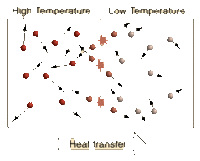Temperature: Difference between revisions
| Line 5: | Line 5: | ||
Temperature is measure of average kinetic energy of the particles in a system. Difference between temperature and heat is that heat is the sum of all the kinetic energies of the particles in a system. Adding heat to a system causes its temperature to rise. Newton's zeroth law states that a system reaches a thermal equilibrium when there is no observable change in temperature between a system. Therefore, the change in temperature causes heat to flow from a high temperature system to a low temperature system. When systems with different temperature is in contact, molecules with higher kinetic energy collide with molecules with lower kinetic energy, kinetic energy is passed from the molecules with more kinetic energy to those with less kinetic energy. This molecular level of kinetic energy transfer will happen until average kinetic energy of the particles in each systems reach the average of two. | Temperature is measure of average kinetic energy of the particles in a system. Difference between temperature and heat is that heat is the sum of all the kinetic energies of the particles in a system. Adding heat to a system causes its temperature to rise. Newton's zeroth law states that a system reaches a thermal equilibrium when there is no observable change in temperature between a system. Therefore, the change in temperature causes heat to flow from a high temperature system to a low temperature system. When systems with different temperature is in contact, molecules with higher kinetic energy collide with molecules with lower kinetic energy, kinetic energy is passed from the molecules with more kinetic energy to those with less kinetic energy. This molecular level of kinetic energy transfer will happen until average kinetic energy of the particles in each systems reach the average of two. | ||
[[File:Tempfigure.gif|thumb|right(position)|]] | [[File:Tempfigure.gif|200px|thumb|right(position)|]] | ||
Revision as of 16:17, 5 December 2015
Defining temperature
Temperature is measure of average kinetic energy of the particles in a system. Difference between temperature and heat is that heat is the sum of all the kinetic energies of the particles in a system. Adding heat to a system causes its temperature to rise. Newton's zeroth law states that a system reaches a thermal equilibrium when there is no observable change in temperature between a system. Therefore, the change in temperature causes heat to flow from a high temperature system to a low temperature system. When systems with different temperature is in contact, molecules with higher kinetic energy collide with molecules with lower kinetic energy, kinetic energy is passed from the molecules with more kinetic energy to those with less kinetic energy. This molecular level of kinetic energy transfer will happen until average kinetic energy of the particles in each systems reach the average of two.

Measurement
A thermometer is a device used to measure temperature. It is placed in contact with an object and allowed to reach thermal equilibrium with the object. The operation of a thermometer is based on some property, such as volume, that varies with temperature. For example, mercury in a mercury thermometer expands to a degree depending on a temperature of the object and the level of the mercury in side the glass tube rises or descends.
Temperature can be measured in numbers by three temperature scales: Celsius, Fahrenheit, and Kelvin. Celsius scale sets freezing point of the water at zero and boiling point at 100, and Fahrenheit scale sets freezing point of the water at 32 degrees and boiling point of the water at 212 degrees. Kelvin scale is designed to go to zero at absolute zero, the minimum temperature.
A Mathematical Model
The relationship between heat transfer and temperature can be modeled with this equation: Q = m c Delta T
The relationship between temperature scales: (degrees)K = 273.15 + (degrees)C (degrees)C = (5/9)*(oF-32) (degrees)F = (9/5)*(degrees)C+32
Examples
Be sure to show all steps in your solution and include diagrams whenever possible
Simple
Middling
Difficult
Connectedness
- How is this topic connected to something that you are interested in?
- How is it connected to your major?
- Is there an interesting industrial application?
History
Put this idea in historical context. Give the reader the Who, What, When, Where, and Why.
See also
Are there related topics or categories in this wiki resource for the curious reader to explore? How does this topic fit into that context?
Further reading
Books, Articles or other print media on this topic
External links
References
This section contains the the references you used while writing this page